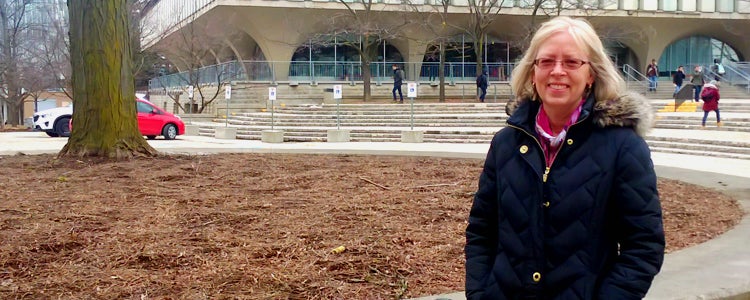Jill Tomasson Goodwin: ePortfolios for Career, Reflection, and Competency Integration
 |
|
Jill Tomasson Goodwin, Drama and Speech Communication |
Written by Ilia Zenkov, Special Projects (Teaching Stories), CTE.
Dr. Jill Tomasson Goodwin believes that university can help students bridge the gap between what they learn in classes and what they will be called upon to do, and to think about, for the rest of their lives.
One key to building this bridge, according to Tomasson Goodwin, is ePortfolios: an integration of a career showcase of artifacts (of things created in class) and a competency reflection (about the transferable skills students deployed to create the artifacts). To show how ePortfolios can connect coursework to the personal growth and careers of students, Tomasson Goodwin undertook research, “ePortfolios for Career, Reflection, and Competency Integration," funded by a LITE Seed Grant.
In this pilot study, Tomasson Goodwin and Katherine Lithgow of CTE explored the effects of guided, graded student reflections on coursework. Specifically, the goal of the research was to find out whether students who wrote reflections about the professional, transferable skills they used to make project artifacts could better articulate these skills to other people six months after the course finished. Transferable skills are those skills -- such as teamwork, communication, decision-making, problem-solving, and leadership skills -- that can be applied from coursework to next-stage career choices, such as graduate school or the workplace.
The research team selected two course cohorts, one of which used ePortfolios while the other did not. Data from the study revealed that the Winter 2015 group, who used ePortfolios to facilitate reflection, transferred their skills more completely and easily from the classroom to next-stage environments than did a Winter 2014 control group, who did not use ePortfolios. Of particular note were the composition of the two groups: the Winter 2015 (ePortfolio reflection group), of whom only 28.5% were in 4B and 53.1% were in co-op, could better provide evidence of professional skills articulation than the Winter 2014 (non-ePortfolio reflection group), of whom 80% were in 4B and 60% were in co-op. These findings suggest that structured ePortfolio reflection helped both co-op and non co-op students in all years better articulate developing transferable skills, even 6 months after course completion.

Guided reflections also help to correct an imbalance in learning. Many students see learning as a product rather than a process: they are focused on the mere attainment of a degree. Their coursework is onerous, their time is limited, and so they do whatever they must, in any way they can, to survive one academic term after another. Often this means that when it comes time to reflect on their knowledge, students are lost: how could a semiconductor physics course help me get into medical school? Moreover, students sometimes acquire transferable skills but fail to see how they might be relevant to a broad range of fields, or they are unable to effectively articulate those skills to potential employers. Getting students to engage in reflection can help to alleviate these blind spots.
Tomasson Goodwin is now undertaking a new study entitled WatCV, along with 22 other colleagues including instructors from various faculties and a rich cohort of academic support staff from across campus. In this project – funded by a LITE Full Grant – Tomasson Goodwin and her team will attempt to integrate the ideas and reproduce the findings of the pilot study throughout the many departments at Waterloo. Ultimately, Tomasson Goodwin’s project supports not only that we should rethink current teaching methodologies, but that the academic atmosphere is enthusiastic about and responsive to new approaches in education. The objective is to make the entire learning experience more visible.
Learn more about the LITE Grant program.
More Resources
CTE has developed more than 100 Teaching Tips. Each one is a succinct document that conveys useful ideas and practical methods for effective teaching. Some of the Teaching Tips that are relevant to the strategies mentioned in this LITE Grant Story include the following: